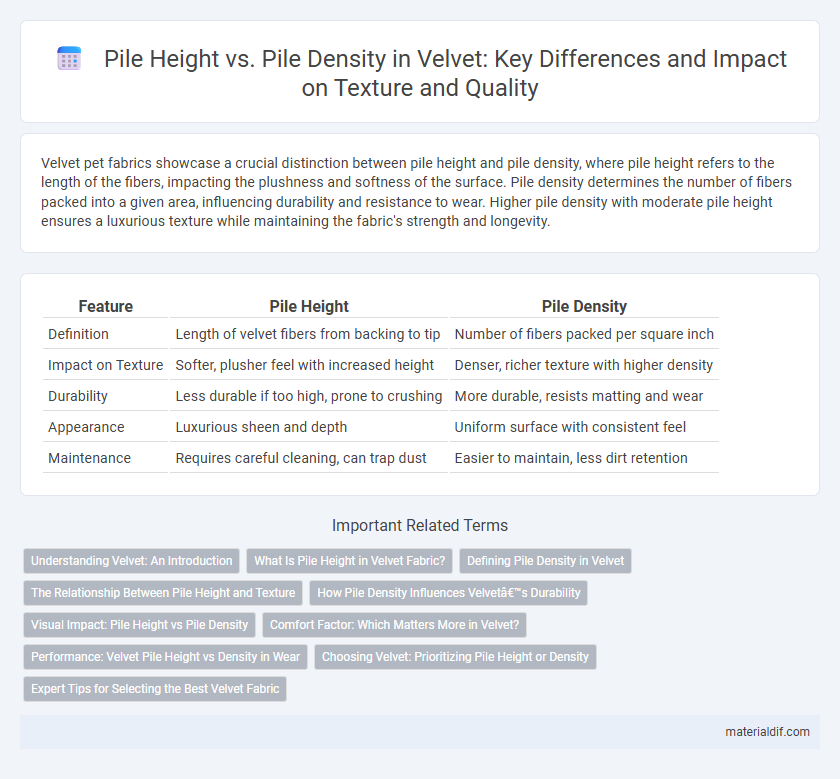Velvet pet fabrics showcase a crucial distinction between pile height and pile density, where pile height refers to the length of the fibers, impacting the plushness and softness of the surface. Pile density determines the number of fibers packed into a given area, influencing durability and resistance to wear. Higher pile density with moderate pile height ensures a luxurious texture while maintaining the fabric's strength and longevity.
Table of Comparison
| Feature | Pile Height | Pile Density |
|---|---|---|
| Definition | Length of velvet fibers from backing to tip | Number of fibers packed per square inch |
| Impact on Texture | Softer, plusher feel with increased height | Denser, richer texture with higher density |
| Durability | Less durable if too high, prone to crushing | More durable, resists matting and wear |
| Appearance | Luxurious sheen and depth | Uniform surface with consistent feel |
| Maintenance | Requires careful cleaning, can trap dust | Easier to maintain, less dirt retention |
Understanding Velvet: An Introduction
Velvet's luxurious texture depends significantly on pile height and pile density, where pile height refers to the length of the fabric fibers and pile density measures the number of fibers per square inch. Higher pile density creates a richer, more durable velvet surface, while varying pile heights influence the softness and sheen, with shorter piles offering a smoother finish and longer piles producing a plush feel. Mastering the balance between pile height and density is essential for understanding velvet's quality, appearance, and application in upholstery and fashion.
What Is Pile Height in Velvet Fabric?
Pile height in velvet fabric refers to the length of the individual fibers that stand upright from the base fabric, typically measured in millimeters. This measurement directly impacts the texture and appearance, with higher pile heights creating a richer, more luxurious feel, while shorter piles tend to be more durable and easier to maintain. Understanding pile height is essential for selecting velvet fabric suited for upholstery, fashion, or drapery applications, as it influences softness, sheen, and overall fabric performance.
Defining Pile Density in Velvet
Pile density in velvet refers to the number of fiber tufts per square inch, significantly influencing the fabric's texture, durability, and appearance. Unlike pile height, which measures the length of the fibers, pile density determines the compactness and plushness of the velvet surface. Higher pile density results in a richer, more luxurious feel and increased resistance to wear, making it a crucial factor in high-quality velvet production.
The Relationship Between Pile Height and Texture
Pile height significantly influences the texture of velvet, with longer pile heights creating a lush, soft feel, while shorter pile heights result in a denser, firmer texture. Pile density interacts with height to enhance durability and tactile sensation, as high density in shorter piles intensifies smoothness and resilience. Understanding the balance between pile height and density is essential for achieving the desired velvet texture, whether aiming for plush luxury or sturdy fabric performance.
How Pile Density Influences Velvet’s Durability
Pile density directly impacts velvet's durability by determining how tightly the fibers are packed together, with higher density providing greater resistance to wear and tear. Velvet with a high pile density maintains its plush texture and appearance longer, reducing matting and crushing from regular use. This compact fiber arrangement enhances the fabric's strength, making it more suitable for upholstery and high-traffic areas.
Visual Impact: Pile Height vs Pile Density
Pile height significantly influences the visual texture of velvet, with longer piles creating a deeper, plush appearance, while shorter piles offer a smoother, more refined look. Pile density determines the fabric's richness and fullness; higher density results in a more luxurious and opaque surface that enhances light reflection and depth perception. Combining optimal pile height and density achieves a velvet fabric with maximum visual impact, balancing softness and vivid color play.
Comfort Factor: Which Matters More in Velvet?
In velvet fabrics, pile height significantly influences the tactile comfort and softness experienced by the user, creating a plush surface that enhances luxury. However, pile density determines the durability and resilience of the velvet, affecting how well it retains its smooth feel over time. Prioritizing pile height generally results in greater immediate comfort, while optimal pile density ensures lasting comfort and fabric integrity.
Performance: Velvet Pile Height vs Density in Wear
Velvet performance in wear depends heavily on pile height and pile density, with shorter pile heights offering enhanced durability and resistance to abrasion compared to longer piles. Higher pile density increases fabric resilience, distributing stress evenly and reducing the risk of crushing or matting under frequent use. Combining optimal pile height with dense packing ensures velvet maintains its luxurious appearance and structural integrity over time.
Choosing Velvet: Prioritizing Pile Height or Density
When choosing velvet, prioritizing pile height enhances softness and a luxurious feel, while higher pile density contributes to durability and a richer appearance. Velvet with a taller pile height tends to reflect light differently, creating depth and a plush texture, whereas dense piles resist crushing and wear, maintaining the fabric's integrity over time. Balancing pile height and density depends on the velvet's intended use, with upholstery favoring density for longevity and fashion pieces often opting for taller pile height for tactile appeal.
Expert Tips for Selecting the Best Velvet Fabric
Selecting the best velvet fabric requires balancing pile height and pile density to achieve the desired texture and durability. A higher pile height offers a plush, luxurious feel, while greater pile density ensures a sturdier fabric with better resilience against wear. Experts recommend choosing velvet with medium pile height and high density for optimal softness combined with long-lasting performance.
Pile Height vs Pile Density Infographic

 materialdif.com
materialdif.com